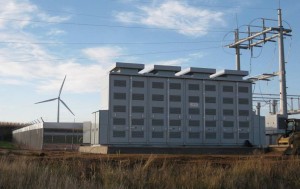 The Energy Storage Promotion and Deployment Act of 2015, recently introduced by Sen. Marin Heinrich (D-NM) and Sen. Angus King (I-ME), seeks to create a National Energy Storage Standard. Similar to a Renewable Portfolio Standard, the storage standard would require electric utilities to meet a percentage of their generation via storage, in this case 1% of peak demand using any energy storage technology by 2021 and 2 percent by 2025. In real terms, utilities would have to add 8 GW of storage by 2021 and 18 GW by 2025.
The Energy Storage Promotion and Deployment Act of 2015, recently introduced by Sen. Marin Heinrich (D-NM) and Sen. Angus King (I-ME), seeks to create a National Energy Storage Standard. Similar to a Renewable Portfolio Standard, the storage standard would require electric utilities to meet a percentage of their generation via storage, in this case 1% of peak demand using any energy storage technology by 2021 and 2 percent by 2025. In real terms, utilities would have to add 8 GW of storage by 2021 and 18 GW by 2025.
Available technologies range from electric and thermal salt batteries to pumped hydro storage and flywheels. When the amount of generated electricity exceeds real-time demand, the electricity can be stored using these technologies and deployed during hours when the ability of generation assets to meet demand is exceeded. In addition to alleviating peaks in demand, this ‘load-leveling’ can also assist in the integration of distributed renewable energy onto the grid and reduce greenhouse gas emissions by limiting the need to rapidly ramp up electricity generation, which can be very inefficient.
Still, emerging storage technology faces planning, procurement and pricing challenges. To effectively utilize storage, utilities and regulators will need to identify the optimal location to place assets. Determining who should be responsible for purchasing storage devices can also be difficult, particularly in states where a utility must get regulatory approval for such investments. Finally, the lack of a clear mechanism to accurately value and therefore price stored energy injects a great deal of uncertainty into the market.
Great discussion post and encouraging legislation! Energy storage is a very challenging problem set especially if the renewables industry ever faces a resurgence as a result of the Clean Energy… Read more »
Seems a little early to assign storage goals. NY state’s new plans are trying a variety of storage options using storage at a variety of points along the generating path.… Read more »
The storage market is just the latest example of the tail wagging the dog in the energy world. What seems to be totally missed is that the largest cost of… Read more »
Bruce, excellent point. Here in the Pacific Northwest, the Federal Columbia River Power Systems (http://1.usa.gov/1SKco1C) is greatly de-optimized because of wind. Wind is “must run” over hydro baseload. In effect,… Read more »
Thanks for this post. It’s good to see a continuing dialogue here on important emerging energy issues such as energy storage. I think Senators Heinrich and King deserve credit for… Read more »
We incentivize electric generation of all types, and we are beginning to provide incentives for energy efficiency – at least for the consumer-side of the equation. But the attributes of… Read more »
Yes, while there are 39 pumped storage plans in operation in the US and 270 either operating or under construction globally, one of the biggest barrier preventing new pumped storage… Read more »
On June 18 I exhibited my “Gallery of Clean Energy Inventions” in the Senior Center of Boulder City. Displayed were images and information on 43 generators, 18 advanced self-powered electric… Read more »
I’d like to comment on the exclusion of energy storage before 2009. An energy storage device placed in operation before January 1, 2009, may not be used to achieve compliance… Read more »
There seems to be a disconnect between the drive for more energy storage and enhancing the attractiveness of renewable distributed electric energy sources. Energy storage upstream of the point of… Read more »
Sorry, I cannot support such a standard in the absence of: – a defined and accepted need; – political acceptance of irresponsible top down planning. The grid operators (ISO) and… Read more »